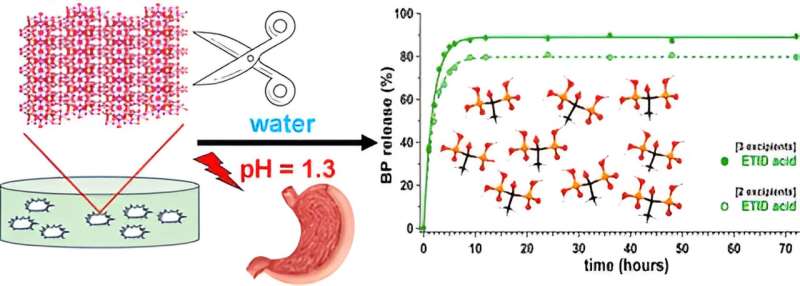This article has been reviewed according to Science X's editorial process and policies. Editors have highlighted the following attributes while ensuring the content's credibility:
fact-checked
trusted source
proofread
Researchers compare controlled release of bisphosphonates

Bisphosphonate (BP) drugs are a common treatment strategy to combat calcium-related metabolic disorders, osteoporosis being the most widely known one. These drugs offer several benefits but are plagued by side-effects. One approach to mitigate these is to utilize controlled delivery and release systems.
In a new joint article, scientists from the University of Crete and the University of Eastern Finland presented the controlled release profiles of 15 bisphosphonate drugs along with kinetics and toxicological data.
It was established that the identity of each drug and its solid-state structural features dictate the controlled release profile in simulated gastric fluid. Based on the results, it may be possible to design safer bisphosphonate drugs that do not have side effects. The results were published in ACS Applied Biomaterials.
In 2005, senior researcher Petri Turhanen from UEF School of Pharmacy and Professor Konstantinos Demadis from UoC Department of Chemistry met for the first time through professor Jouko Vepsäläinen. Professor Demadis had a research idea related to phosphocitrate (PC).
PC is an important biomolecule found in mammalian cells, but in those days its chemical synthesis methods were very limited. The idea of a new methodology for the synthesis of PC was put in motion, and two years later, a novel method for the synthesis of PC was materialized and published.
Later, the collaboration turned to the field of BP chemistry. "Here in Kuopio, we have a very strong expertise on the synthesis of diverse types of BPs and derivatives, whereas Professor Demadis and his group are experts in the field of Crystal Engineering, MOF design, synthesis, and characterization. Professor Demadis' idea was to design and fabricate appropriate drug delivery platforms that would be able to demonstrate BP controlled release features, thus alleviating the side effects of BPs," Turhanen says.
Such systems became a reality, focusing on drug hosts such as silica gels, laponite gels, and, most importantly, coordination polymers (with biocompatible metals), in which the BP drug is an integral part of their structure.
The first joint publication on the controlled release of BPs from silica gels was published in 2017 and was the start for a more intensive and creative collaboration. In addition, joint publications, the collaboration has led to two Ph.D. Theses and six Master's Theses, among other things.
International collaborations are very important for the progress of science, but such a long-lasting and productive collaboration is rare. According to the researchers, there are still more joint papers to come.
More information: Maria Vassaki et al, Structural Diversity in Antiosteolytic Bisphosphonates: Deciphering Structure–Activity Trends in Ultra Long Controlled Release Phenomena, ACS Applied Bio Materials (2023). DOI: 10.1021/acsabm.3c00770
Provided by University of Eastern Finland





















